One of the more amusing changes that Star Trek: The Next Generation made to the Trek mythos was to mess with the color scheme. In the original series, command wore gold, operations wore red, and science wore blue. Among other things, this meant that security guards wore red, and their constantly dying on landing parties led to “redshirt” coming to be synonymous with “dead meat.”
So TNG switched it up so that the people in red were now in command, which did precisely nothing to slow down the redshirt meme.
This week on Lower Decks, they make a pretty funny joke out of it.
SPOILERS AHOY!
There’s quite a bit going on in “The Spy Humongous,” but most of it actually works. This isn’t a great episode of Lower Decks, but it’s rather a good one.
For starters, this is the best use of Kayshon yet. He still talks normally, but uses Tamarian phrases as interjections. I’m just happy to see him actually be part of the plot, as he and Ransom are charged with showing a Pakled named Rumdar around who has requested asylum.
The Cerritos is on the Pakled homeworld, which is simply called Pakled Planet, with Captain Freeman on a mission to negotiate a cease-fire with the Pakleds. Freeman is hoping this will lead to better missions for her and her ship, but things go wrong in a hurry. The Pakleds think she’s Captain Janeway (who’s actually an admiral at this point, but whatever), it’s not clear who’s the leader (it’s supposed to be the person with the biggest helmet, but we keep getting new people with even bigger helmets showing up), and Rumdar, one of their prisoners, is missing.
Ransom and Kayshon are pretty sure Rumdar is a spy—mostly because he immediately asks to see sensitive areas of the ship right after he requested asylum on the Cerritos—and so they take him on a tour of the nonessential parts of the ship, including the gift shop. I must admit, the visual of a Pakled wandering around wearing a bright blue Cerritos T-shirt is a delightful sight gag.
Unfortunately, Ransom and Kayshon lose Rumdra. Worried initially that he outsmarted them, they soon realize that he actually outdumbed them. He went to the bathroom, except it was an airlock, and when he hit what he thought was the flush button, he got blown out into space. They’re able to rescue him, and T’Ana is able to revive him, and he’s sent back to Pakled Planet, where he reveals, to no one’s surprise, that he’s actually a spy. Freeman is able to trick Rumdar into giving away the Pakleds’ next planned attack, and everything.
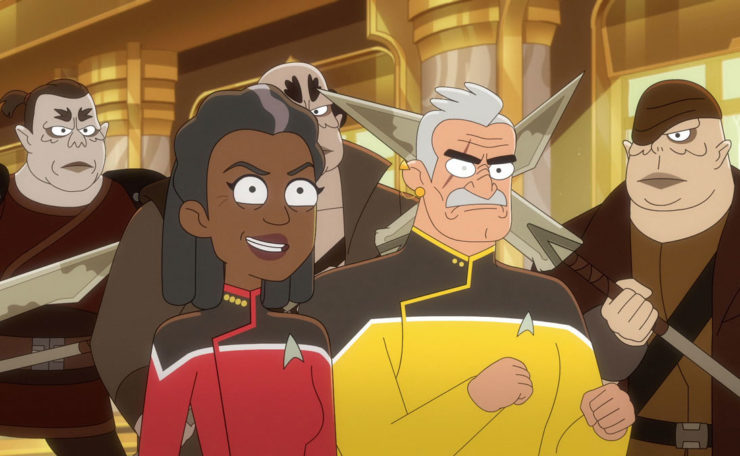
Meanwhile, our four main characters have Anomaly Consolidation Duty, about which Tendi and Boimler are excited and Mariner and Rutherford are not so much. Tendi thinks it’s incredibly nifty that they get to collect the various weird-ass things that folks have picked up on away missions and catalogue and ready them to be sent off to a facility for study. Mariner just thinks it’s taking out the senior staff’s trash.
This is the sort of thing that’s most fun about Lower Decks. Things like this and second contact show the parts we never get to see on the mainline shows: what happens next. The drudge work, the cleanup, the paperwork, and all that stuff that is too mundane for a one-hour show about people having adventures. (It’s also why cop shows rarely show them doing paperwork, which is actually about 85% of their job.)
And the random crap they find is hilarious, more so because it’s Mariner who is on the receiving end of most of the things that go wrong with them: a formless gelatinous mass that swallows Mariner up, e.g. But Tendi and Rutherford aren’t spared: Rutherford is made into a giant blob, and Tendi is swallowed and excreted by an alien being.
That last bit provides a great line from Mariner: “Who among us hasn’t been pooped out by an alien creature?” It’s one of the main changes that Trek underwent in 1993.
See, prior to the debut of Deep Space Nine, Star Trek was about the voyages of the Starship Enterprise. And you just assumed that the Enterprise was special, because it’s the best ship with the best crew in the fleet, and they were the ones who encountered the weird anomalies and the beings of pure energy and so on.
But with the advent of the spinoffs that didn’t take place on a ship called Enterprise, suddenly it changed. It isn’t just the Enterprise that encounters the crazy-ass shit, because we saw the Defiant, Voyager, Discovery, and now the Cerritos coming across all the same sorts of loony stuff that Kirk and Picard did.
And I love that. And it also means that, if you’re in Starfleet, this is the nonsense you have to deal with every single day. So it’s very easy for someone who’s been in Starfleet as long as Mariner to view ACD as nothing more than taking out the garbage, because she’s seen it all and done it all.
Tendi, though, is still new to Starfleet, and she’s loving all the cool stuff they’re collecting—right up to the part where she’s pooped out of an alien. Then she loses her temper—right when she’s holding a glowy pink cube, which turns her into a giant green scorpion, because of course it does.
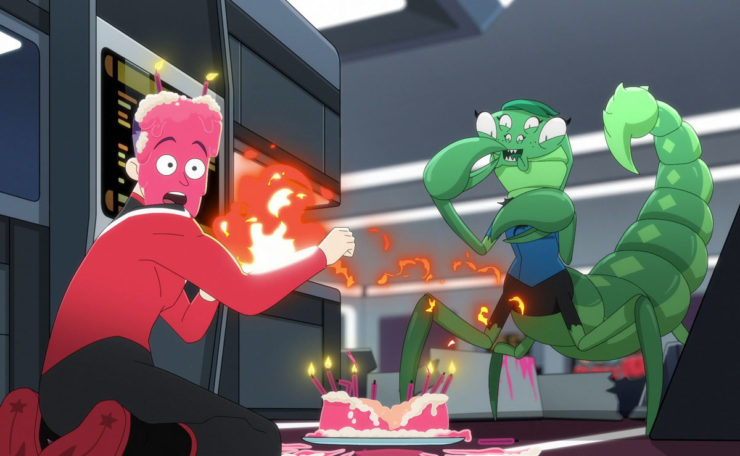
It’s up to Boimler to save the day. You’ll note that, even though he had the assignment to do ACD, he wasn’t actually part of it. That’s because a group of command-track officers have sucked him into their clique. They call themselves “redshirts,” which Boimler and the viewer are both dubious about. This works perfectly as a meta joke, because most folks watching this know that, over the last five decades, “redshirt” has come to mean “the person who dies but nobody really cares about.” But in-universe, it’s a reasonable nickname for these ensigns on the command track to use, so the joke is even funnier.
In any case, the redshirts are led by Casey, and include Jennifer the Andorian from “Strange Energies,” as well as a human woman and a Kzinti male. They want Boimler to join them in their clique, which is dedicated entirely to fast-tracking themselves into the captain’s chair. Boimler’s tour on the Titan make him someone they want to get to know better, as his experiences under Captain Riker are invaluable insights into how to become captain.
It soon becomes clear that the redshirts are really good at looking and acting like captains, but missed the memo on behaving like captains, because when Tendi-the-scorpion menaces the mess hall, the redshirts all step forward and make inspirational speeches, while Boimler actually wades in and does the work to stop Tendi’s rampage and also turn her back into an Orion. Casey is appalled by this—especially since the solution turns out to be making a fool of himself to make Tendi laugh. While her anger and frustration turned her into a scorpion, being amused reverses the transformation, which is delightful. (And also gives us the visual of Boimler covered in beans, birthday cake, and other foods.)
Buy the Book
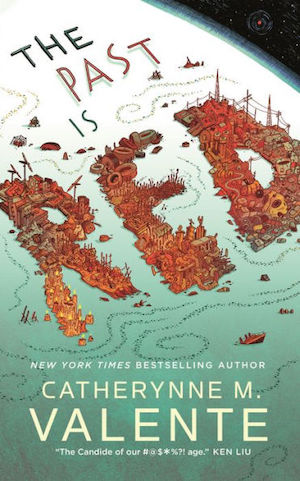

The Past Is Red
To the redshirts’ credit, they realize that their goals are less than efficacious, and that they’re in Starfleet to help people, not further their own ambitions. Casey, notably, is the exception here, and he proudly gets the job of acting captain on his next bridge rotation—which means he gets to sit in the center seat for about four seconds before Shaxs relieves him and assigns him to clean the airlock the Pakled used as a bathroom.
The Boimler and the Redshirts (which is totally the name of my next band) plotline plays nicely with two different aspects of Trek. One is the disconnect between “senior staff” and the rest of the ship. Casey and the gang are constantly talking about how they’re more important than the lower-decks crew, even though Boimler reminds him that they are all the same rank. This is an amusing play on the shows’ tendency to have only the people in the opening credits do anything important, most notably Voyager referring to the “senior staff” as the folks in the credits, going so far as to have Kim, Seven, and Neelix doing things that really should be done by senior officers rather than an ensign and two civilians.
The other is the flip side of the trope that the crews we usually see in action are supposed to be the best and the brightest. But there’s a corollary to that: if these are the best, it means there have to be others that are less than the best. While it’s true that Casey doesn’t quite live up to the Starfleet ideal, not everyone is going to. Even in paradise, some people are going to be moved by ambition over idealism. What makes this work is that, even if this does feel too much like a 21st-century office plot, it’s one that still mostly works in the context of a Star Trek story, especially given that the other three members of the redshirts come around to Boimler’s POV by the end. (For that matter, Mariner realizes that she shouldn’t have rained on Tendi’s parade and should try to take pleasure in the discovery of nifty new things.)
The only part of the plot that didn’t ring right for me was Rutherford being on Mariner’s side of the ACD-is-boring argument. Rutherford should’ve been right there with Tendi geeking out over the cool things they found.
But still, this was fun. And hey, once again, it isn’t Mariner who saves the day, it’s Boimler (and Freeman gets to score a victory against the Pakleds). This is definitely trending in the right direction…
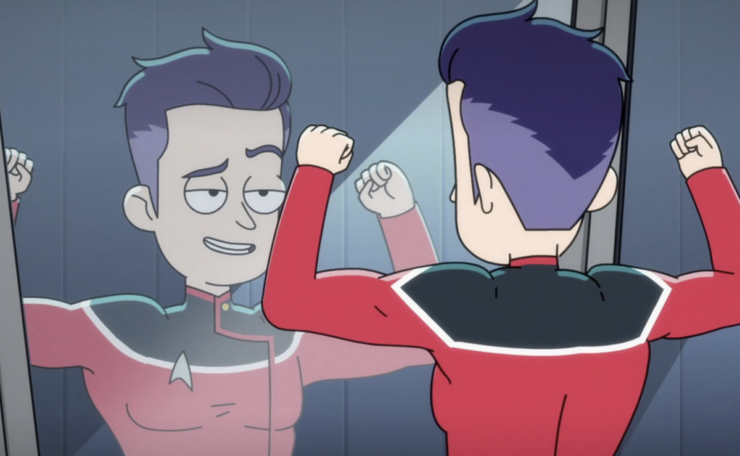
Random thoughts
- The sequences on the Pakled Planet are particularly amusing in that we keep meeting different leaders, and there’s even a revolution to overthrow the leader with the biggest helmet, only to have the Pakled who led the revolution put on the biggest helmet. Nothing actually changes with the Pakleds during any of this. They still think Freeman is Janeway, and they still think they have the upper hand on Starfleet and they still think Rumdar is a good spy.
- At one point, Shaxs says that if Freeman keeps getting Picard-type missions, she’ll get an Enterprise to command. Once again, the writers treat the characters like they watch the Trek TV shows instead of live in the universe where they take place. Sigh.
- Also, Shaxs was killed in a mission against the Pakleds, shouldn’t that have come up at some point when he’s on an away mission to Pakled Planet?
- At one point, the prisoner asks to see the “crimson force field.” This is an amusing callback to TNG’s “Samaritan Snare,” when Riker, Gomez, and La Forge tricked the Pakleds into thinking that red discharge from the Bussard collectors was a “crimson force field.” Apparently, the Pakleds still think it’s a thing fifteen years later.
- Prior to their becoming a recurring antagonist on LD, the Pakleds’ only previous appearance of note was in the aforementioned “Samaritan Snare” (plus appearing as background extras on DS9 and a mention in TNG’s “Brothers”), but I’d be remiss if I didn’t mention the novella that focused on them in the Seven Deadly Sins anthology, the perfectly titled “Work is Hard” by Greg Cox. That anthology had a species in the Trek universe representing one of the titular sins, with the Pakleds, unsurprisingly, representing sloth.
- The episode closes with our four main characters holding a device that allows you to throw your voice onto a planet. They use it to torment Armus, the sentient oil slick that killed Tasha Yar in TNG’s “Skin of Evil.” Why the producers felt the need to call back to that episode of all episodes is left as an exercise for the viewer.
- Finally, the best joke in the whole episode was when the redshirts are working with Boimler on improving his appearance to make himself more captaincy. They adjust the fit of his uniform and recomb his hair, for starters. But the Kzin dings him for his posture. He demonstrates how Boimler walks by hunching over, at which point he looks exactly like the Kzinti we saw in “The Slaver Weapon” on the animated series. Then he straightens up again.
Keith R.A. DeCandido is thrilled to be part of the upcoming anthology Three Time Travelers Walk Into…, which was just successfully crowdfunded on Kickstarter. The anthology is now open to submissions—you can find the guidelines here.


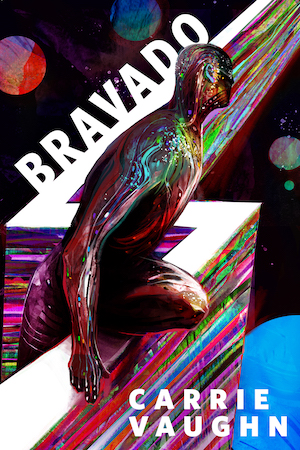
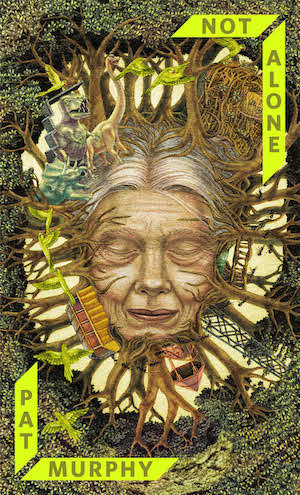
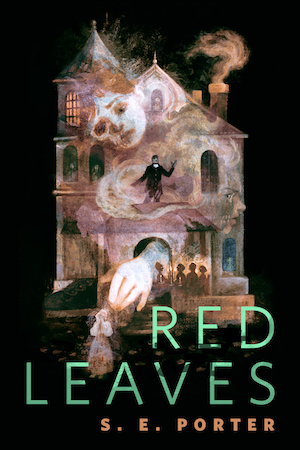
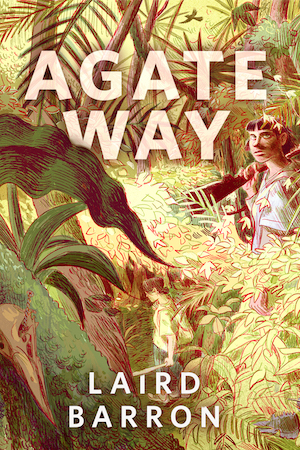




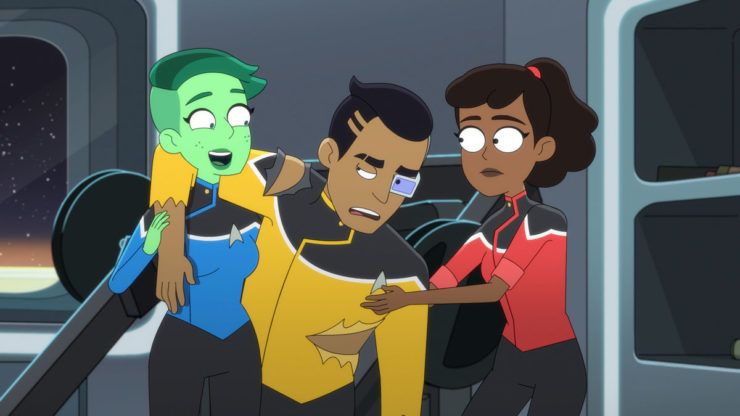
Q works beautifully on TNG because deLancie and Sir Patrick Stewart have simply perfect chemistry, which will likely hold true when the entity appears on Picard. His appearances on Voyager have been a sequence of diminishing returns, and when they finally address the elephant in the room regarding the fact that Q can get them home with a snap of his fingers, they botch that, too. Just a sodden, awful mess.
As I said back in…I think it was either the “Death Wish” or “Q and the Grey” talkbacks…”All Good Things” really should’ve been Q’s swansong — at least at the time.
I mean, we’ll have to see how his encore on the new Season of Picard fares (and his Lower Decks guest role was at least fun).
But I didn’t really care for this episode back in 2001 either — and not just because, at the time, it seemed a poor sendoff for DeLancie (since, as far as we knew, VOY’s final Season was the last hurrah of the 24th Century on TV).
Q’s crossover appearance on DS9 in retrospect should’ve been a warning that he wasn’t going to work outside of TNG — apart from, heh, Sisko decking Q.
Yes, a massive letdown and an unfortunate cheapening of the Q concept — never a great concept, but at least it had a certain consistency that’s largely discarded here. A Q child acting the same as a human adolescent is rather ridiculous. Q are transcendent beings that merely cosplay as humans so that we may comprehend them. It’s the equivalent of a zookeeper using a vulture hand puppet to feed baby vultures. It doesn’t reflect the underlying reality.
True, Voyager has made that mistake all along, with Q’s flirtations with Janeway. Although at least that had the excuse of giving close friends Kate Mulgrew and John DeLancie an opportunity to play Hepburn and Tracy together. Having q send Seven’s catsuit to the cornfield is just juvenile pandering.
The one thing about this episode that I’m grateful for is that it set the end of Kirk’s 5-year mission in 2270. The Okudas’ Chronology had conformed to Roddenberry’s preference that the animated series be ignored and had put the end of the 5YM in 2269, shortly after “Turnabout Intruder,” and thereby left virtually no room for either TAS or any of the novels or comics. Putting the end in 2270 provides room for those things again, at least up to a point.
Well, one more thing. Icheb’s mention of Kirk saving the Pelosians from extinction shortly before the end of the 5-year mission was the basis for my version of the end of that mission, which I described in retrospect in Ex Machina and then depicted in Department of Temporal Investigations: Forgotten History. As for the other two species Icheb mentioned as being saved from extinction by Kirk years earlier, I covered them more recently in The Captain’s Oath.
Thank you for the cornfield reference. The shot (pictured above) of Neelix without a mouth is 100% “It’s A Good Life” and just as horrifying and sudden.
“That’s all the television there is!”
The best part about Q appearing in Star Trek Picard season 2 is that this will no longer be the final appearance of the character.
Steven: Well, it wasn’t anyhow, thanks to Q’s appearance in “Veritas” on Lower Decks.
—Keith R.A. DeCandido
@4/krad: And Q was back in his Post-Atomic Horror Judge cosplay in “Veritas,” raising the same question you raised about the Q judges here.
Christopher: True, but I can forgive the deLancie Q wearing it out of nostalgia, if for no other reason. (Out of the box, it also made it easier for him to be identified given the rather simplistic animation style of LD….)
—Keith R.A. DeCandido
@3,
The best part about Q appearing in Star Trek Picard season 2 is that this will no longer be the final appearance of the character.
I’m still on the fence about bringing back Q at all — at least into Picard’s corner of the franchise.
I was fine with “All Good Things” being Q’s final appearance within the context of TNG and its own overrarching narrative. His final scene with Picard in the Court Room was, and still is, a perfect sendoff.
As happy as I am to see DeLancie snapping his fingers again, I’m still concerned Q’s role in the new Season of Picard will cheapen that.
The challenge is going to be what more you can add to the Picard-Q dynamic at this point.
One thing I can say in this episode’s favor is, in my opinion, the Janeway / Q dynamic works better here than in the previous two episodes, and I actually really enjoyed the dynamic in this episode. Q’s not trying to do that stupid pursue-Janeway-as-a-love-interest thing, he’s just trying to be a good parent. And I can see Janeway as one to give better parental advice than Picard would.
I had almost totally forgotten about this episode. Offhand, I’d recalled that Keegan deLancie played Q’s kid on Voyager, but I hadn’t recalled that it wasn’t part of “The Q and the Grey” or something.
“Don’t you Aunt Kathy me.” Deja Q was a better episode, but only because that’s one of the few Q episodes I really enjoyed (along with Tapestry, but Q seems a minor part there). They were more often than not tied in with boring holodeck type silliness. I also think Janeway’s role and performance were strong overall, and she does a good job as godparent. I also liked Itchy and Q-ball palling around. My heart broke a little at Q’s reaction to q’s essay. At least they provided a half-hearted reason why Q doesn’t send them home this time. Uses Janeway’s own words against her.